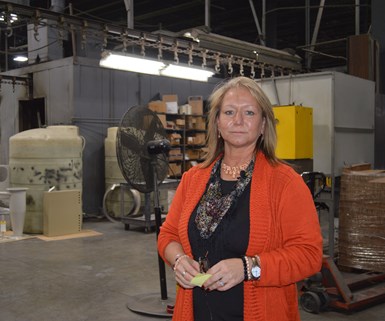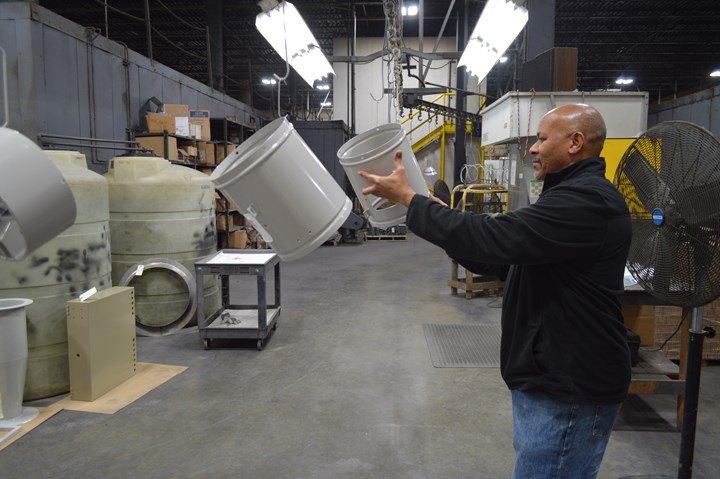
JIT Powder Coating’s conveyor system is one of the longest in the Twin Cities area. Photo | Tim Milner
Tim Milner doesn’t want to talk about himself, his powder coating operation or the equipment in his spacious facility in Farmington, Minnesota.
Instead, the president and owner of JIT Powder Coating Company wants visitors to get to know his management team, which consists of Ann Franson, vice president of finance and administration; Douglas Harper, vice president of operations; Rhonda Schmitt, customer service manager; William Riascos and Brian Hofmeister, account managers; and Gary Petrash Jr., maintenance manager.
Featured Content

Ann Franson, vice president of finance and administration for JIT Powder Coating Co.
“Those are the people who make it happen, not me,” says Milner, whose powder coating operation is a perennial Products Finishing Top Shops award recipient. “I’ve intentionally hired in such a way as to ensure that we have age diversity. I have some 50-year-olds on our management team, some 40-year-olds and a real mix. It’s all about the next generation for our company.”
Milner’s business philosophy rests on delivering quality coated parts to a smaller group of customers than most shops would be courting. For Milner, that means focusing on his employees, keeping them happy and ensuring their buy-in. Because of their small customer base, it’s really all about maintaining good relationships.
“When I started this company in 1993, I came from a facility that had over 800 customers, yet just 40 of them really contributed to financial success of that company,” Milner says. “They all had demands, but routinely a smaller customer would get in the way of a bigger customer. That always caused problems and hurt our reputation. I just decided when I started my company, I would do it a little different.”
Fewer Customers, Deeper Connections
The approach has meant a smaller customer base, but a deeper relationship with those customers. He instills the value of these relationships in his employees and management team, most of who have been with him for decades. Franson has been with JIT for 22 years and covers human resources, payroll, financials and all administrative needs. Harper has been there for 25 years and handles all scheduling and production-related issues. Schmitt has been with JIT for 22 years and is the first point of contact for customer needs. Hofmeister has been handling quotes and customer accounts for 10 years. For the last nine years, Petrash has been dealing with all maintenance and safety-related issues. Riascos, who recently transitioned to director of quality, is a newbie at five years.

JIT puts a focus is on people — making sure employees are happy and delivering quality coated parts to its customers. Photo | Tim Milner
“It truly is a team, and we all work very well together,” says Milner, who started JIT in 1993 in Fridley and opened their Farmington facility in 1995.
The company closed Fridley in 2000 and focused on expanding the Farmington location, which eventually happened in 2006. The facility has 52,000 square feet with 42,000 for manufacturing and 10,000 for office and warehousing, including eight loading docks, a ground-level loading area, a half-acre paved storage yard, pallet racking and a mezzanine.
The Fridley location which was 30 miles from the Farmington facility and its closing meant that some employees had to decide if they wanted to make the switch to the expanded facility or find work close to home. Milner stepped in and assisted those employees who wanted to move closer to the facility, which he saw as an investment in his most important asset — his employees.
Still, there was a group who couldn’t make the move. Rather than lose those three employees, Milner bought a small van and the group drives it roundtrip to Farmington every day. Both the employees and Milner couldn’t be happier.
“They are some of my best people, so I wanted them to stay with us,” he says. “I’ve had to buy a few vans over the last 20 years, but it has been well worth it to have their experience, their leadership and their loyalty with us all these years. It’s a great value to us.”
Large Coating and Curing Equipment
JIT Powder Coating’s main line conveyor system is 850 feet long and is rated for 75 pounds per foot, giving the shop one of the longest, heaviest conveyor systems in the Twin Cities area. The part window size is 5 ft x 3 ft by 11 ft, and the line speed ranges from 6-12 feet per minute (FPM), with an average line speed of 8 FPM, which results in a process cycle time (first part on to first part off) of around two hours.

The main line conveyor system has nearly 250 linear feet of conveyor line inside the oven, giving JIT over 30 minutes of cure time at its average line speed of 8 FPM.
Installed in 2016, the conveyor system uses a Gema Magic system for coating parts that includes eight automatic spray guns and optional manual touch up before and after the automatics. Their color change time is under 12 minutes, and the Gema cyclone reclaim booth allows JIT to economically recover over-sprayed paint for any production run lasting 60 minutes or more. The conveyor system has a 6-stage spray wash system using alkaline cleaners, iron phosphate surface treatment, an optional non-chrome sealant, and a RO rinse.
The main line conveyor system has nearly 250 linear feet of conveyor line inside the oven, giving JIT over 30 minutes of cure time at its average line speed of 8 FPM. This allows even parts that have substantial mass to reach metal temperature for curing. They also have a smaller 260 feet conveyor system that is rated for 25 pounds per foot with a line speed 2-4 FPM that focuses on smaller runs and Class A finishes.
What really sets JIT apart is the ability coat extremely long parts in a batch booth. The company can coat parts up to 45 feet long and has tooling to handle parts up to 1,000 pounds. One driver for JIT’s investment in this capacity is their largest customer who builds light poles directly across the street.
“Over the years, we have expanded and increased our booth and oven sizes and added capacity to meet their needs,” Milner says. “They use forklifts to drive them directly across the street over to our shop for coating.”
JIT also has over 3,000 square feet and work staff dedicated to light assembly and custom packaging, allowing them to eliminate the need for customers to handle parts after powder coating.
Taking a Leap of Faith
Milner got his start in the finishing industry while working for a chemical company that wasn’t wholly related to the industry. When a friend asked him to consult with a paint shop in Minneapolis on some issues they were having, Milner took the project and eventually joined them as their quality director in 1987. When the investment group that owned the facility sold it in 1993, Milner decided to take the dive and branch out on his own in the finishing industry, renting a powder coating facility that had gone out of business.

Douglas Harper, vice president of operations for JIT Powder Coatings, inspects a part on the shop floor.
“I used some of their existing equipment, took $25,000 out of my own pocket, and matched it to a $100,000 Small Business Association loan,” he says. “I was taking a huge leap of faith to invest in restarting a business that went bankrupt.”
Milner grew the business fairly quickly, but soon learned the dangers of ownership when his largest customer went bankrupt in 1998. He was left with $380,000 in unpaid invoices, a setback that took him another four years to overcome.
“It was hard work, but we came back,” Milner says. “I’ve kept that in the back of my mind as we built this business and took on customers. But I knew if I had a great team around me that we could grow together, and we have. That’s what I’m proudest about.”
Visit jitpowdercoating.com and gemapowdercoating.com.
RELATED CONTENT
-
Calculating Oven Heat Load Capacity
Please explain how to calculate the heat load capacity of a paint baking oven, using aluminum alloy wheels as an example.
-
Understanding Infrared Curing
Infrared cure is gaining increased attention from coaters as a result of shorter cure cycles and the possibility of smaller floor space requirements when compared to convection oven curing.
-
Removing Cured Powder Coatings
Question: What methods are available for removing cured powder coatings, and what are the pros and cons of these methods?



















